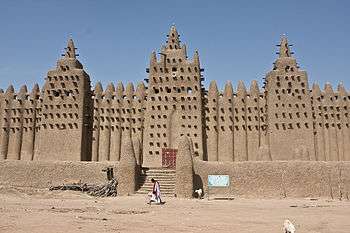Djenné
Djenné is a city in Mali, famous for its mosque, which is the biggest mudbrick building in the world. As of 1987, the city had a population of 12,000. Djenné has been recognized as a UNESCO World Heritage Site. UNESCO says on its website that "Djenné became a market centre and an important link in the trans-Saharan gold trade."

Get in
The best day to find transport to Djenné is Monday - market day - when many minibuses and bush taxis make their way to the town. Otherwise you may need to take transport to the Djenné junction on the main Bamako-Mopti road, and wait for further transport to Djenné.
Get around
For traveling short distances walking may be the best method as it allows you to appreciate the scenery and look at the mud based architecture in the city.
When the river is high, you can take a pinasse to nearby Fula villages.
See
- 🌍 The Great Mosque. This is the main tourist attraction in the city. It is what made the city a UNESCO heritage site.
Do
- Market. On Monday, the Grand Market assembles -- and quite a incredible spectacle it is too!
Buy
Eat
- Le Campement (North of the Grand Mosque). The menu du jour here is 4000CFA - but it is mediocre.
Drink
Sleep
- 🌍 Le Campement (North of the Grand Mosque). The rooms here are decent enough and well-priced at 10000CFA.
- Hotel Djenne, Doteme Tolo. This is a newly built hotel that includes a restaurant $69.
- 🌍 Djenne Djenno (Outside of the city), ☎ +223 7933 1526, e-mail: res@hoteldjennedjenno.com. Owned by a Swedish expat, this "malian boutique" mud brick hotel is richly decorated with traditional textiles from the local Bogolan tradition. Has an on-site restaurant and also organizes excursions. From 26000 CFA per night.
Connect
Go next
On Tuesday morning there is a minibus to Bamako leaving at around 7:30 (7500CFA). (It may operate other mornings, too - check.)
Otherwise, for westbound destinations you can get a minibus headed for Sevare and get off at the junction with the main road (2500CFA), where frequent buses run to Sissako and Bamako.